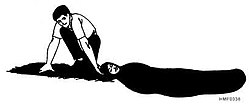m (+ translate tags) |
(Marked this version for translation) |
||
| Line 1: | Line 1: | ||
| − | <noinclude><translate></noinclude> | + | <noinclude><translate><!--T:1--> |
| + | </noinclude> | ||
[[Image:Blanket_drag.jpg|thumb|250px|right|Blanket Drag]] | [[Image:Blanket_drag.jpg|thumb|250px|right|Blanket Drag]] | ||
The blanket drag can be used to move a person who, due to the severity of the injury, should not be lifted or carried by one person alone. Place the casualty in the supine position on a blanket and pull the blanket along the floor. Always pull the casualty head first, with the head and shoulders slightly raised so that the head will not bump against the floor. | The blanket drag can be used to move a person who, due to the severity of the injury, should not be lifted or carried by one person alone. Place the casualty in the supine position on a blanket and pull the blanket along the floor. Always pull the casualty head first, with the head and shoulders slightly raised so that the head will not bump against the floor. | ||
Revision as of 23:04, 23 April 2015
The blanket drag can be used to move a person who, due to the severity of the injury, should not be lifted or carried by one person alone. Place the casualty in the supine position on a blanket and pull the blanket along the floor. Always pull the casualty head first, with the head and shoulders slightly raised so that the head will not bump against the floor.

